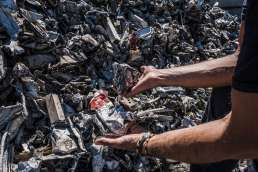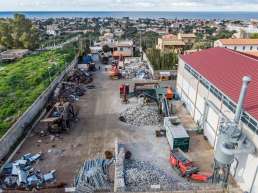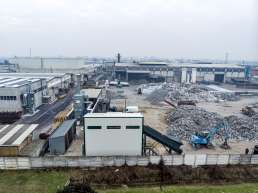Energy efficiency: challenges and solutions in metal recycling
Today, energy efficiency is a primary driver for the recycling sector. In this article, we investigate how it can become a meeting point between environmental and economic sustainability.

Energy efficiency has become one of the key benchmarks in the assessment of plant performance. Not only because it does have a direct bearing on operating costs, but also because it reflects a company’s ability to adapt, innovate and compete. However, it is no longer just an environmental issue, but a core issue to ensure the economic sustainability of businesses. This is particularly true for the metal treatment and recycling industry, where energy consumption has a direct impact on profitability and competitiveness.
Today, businesses are required to tackle two parallel pressures. On the one hand, the energy cost, subject to strong fluctuations, significantly impacts operating margins. On the other hand, European and international environmental regulations are pushing for a tangible ecological transition, based on traceable processes, reduced emissions, and optimized consumption. Against this backdrop, energy efficiency is the most effective response to both challenges.

Energy-intensive plants vs. optimised plants
In the metal recycling sector, the difference between an energy-intensive plant and an optimised one does not only concern power consumption, but the entire production logic. Older systems tend to require consistently high power, regardless of the type of material being processed. This leads not only to significant energy waste, but also to greater wear and tear on mechanical components, rough control of operating parameters, and generally lower productivity.
On the contrary, a system designed according to efficiency criteria can adjust the absorbed power to the actual load, ensuring process stability and energy consumption proportionate to yield. The adoption of high efficiency motors, intelligent inverters, modular configurations and monitoring systems makes it possible for you to take action on the progress of the system in real time by optimizing each phase and reducing both operating costs and environmental impact.
In a direct comparison, the difference between the two models is reflected in numbers: with the same number of tons treated, an optimised plant can generate significant energy savings, increase hourly productivity and ensure more consistent, exploitable output. Choosing modern technologies does not just mean upgrading a machine but rethinking the production cycle with a view to greater overall efficiency.
Modular and flexible, Panizzolo plants ensure high-efficiency End-of-Waste treatments, reducing operating costs and generating sustainable long-term value.

The numbers of efficiency
Metal recycling is, in itself, a virtuous choice from an environmental point of view. However, it is energy efficiency that establishes its real impact. Some data help to understand the scope of this opportunity. When it comes to aluminium, for instance, recycling makes it possible to save up to 95% of energy compared to primary production. Producing one ton of aluminium from bauxite requires over 51,700 kWh, whereas just 2,300 kWh are required through recycling.
Even for steel, advantages are significant. The estimated energy savings compared to production from iron ore vary between 60% and 74%. On an environmental level, recycling one ton of steel prevents us from mining over one ton of iron ore, thus curbing air pollution by up to 86%, water pollution by 76%, and saving water by as much as 40% with respect to primary production.
Efficiency in economic terms
In addition to the obvious environmental benefits, energy efficiency is a pivotal element for the economic sustainability of businesses. Energy consumption is one of the main cost items in the daily management of a plant. As already highlighted, an obsolete machine consumes more, requires more maintenance and produces less efficiently, thereby adversely impacting overall margins.
Investing in efficient systems means reducing operating costs, increasing productivity per kilowatt hour consumed and improving return on investment. Furthermore, energy efficiency grants access to tenders and public funding, which are increasingly allocated to the benefit of ecological transition projects. In a scenario where ESG criteria become a discriminating element in purchasing decisions and supplier selection, efficiency also becomes a competitive advantage in business and reputation terms.

Technology, strategy and positioning
Choosing efficient technologies, therefore, is no longer just a technical or environmental issue – it is also a strategic decision. Companies that embrace modern solutions, capable of combining high performance and low energy impact, develop a strong positioning strategy in the most advanced markets. In international B2B relationships in particular, energy efficiency is key to being perceived as reliable, sustainable and innovation-oriented suppliers.
Cutting down on consumption means being more resilient against energy price increases and more flexible in production cycle management. Not only that. Also responding to the expectations of customers who are increasingly sensitive to the issue of sustainability and looking for partners who can support environmental and safety goals as well as reduce the carbon footprint.

Panizzolo’s approach to energy efficiency
Truly achieving energy efficiency requires an integrated approach. It is not enough to take action on single process stages, but it is necessary to reappraise the entire plant based on technologies, materials treated and production targets.
It is along these lines that Panizzolo’s solutions fit in: a complete range of scrap grinding, sorting and refining plants, designed to maximize performance while minimizing consumption. Highly efficient components, intelligent software and real-time control systems enable to optimize every treatment stage, thereby ensuring operational continuity even with mixed or complex materials. Modular configurations also allow the system to be sized according to actual requirements without oversizing and waste. To complete the offer, a customised technical consultancy service supports the customer in the production cycle design and optimization, with a view to combining energy efficiency, environmental sustainability and economic return.
This approach enables us to transform efficiency into a tangible value by making each plant not only more efficient, but also more competitive, resilient and capable of generating long-term value.